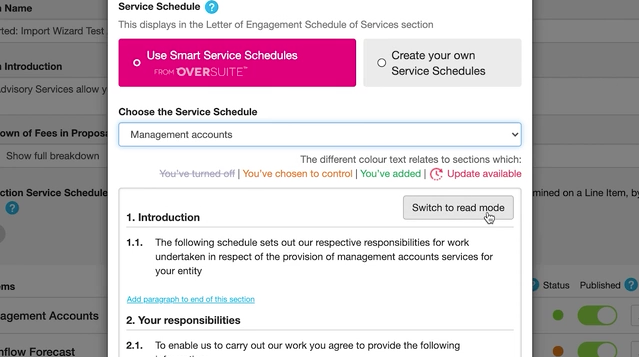*This article has been developed with the UK market in mind. If your accounting firm isn’t UK based, please consider how any advice mentioned would translate to your country’s market.
Let’s be honest. If you have the choice between writing out an engagement letter or plucking an engagement letter template from the internet, the latter certainly seems a better use of your time.
But are engagement letter templates worth the pages they’re written on? Or is it a shortcut that’s leading you down a dangerous path?
What is a client Engagement Letter?
An engagement letter is effectively simpler than a contract, but it’s still a legally binding document. Any business that provides a service should have one in place with their clients.
The letter should define the relationship between you, detailing the scope of work you agree to do, the terms and duration of such work, and, of course, the cost it will incur.
Put simply, it’s a written confirmation of the work you’re going to do.
What does an Engagement Letter do?
See your engagement letters as a coat of armour for your firm. When done accurately, they protect you from any nasty surprises by minimising risk of any possible miscommunication between you and your client.
An engagement letter isn’t just a helpful document for you – it’s a valuable reference point for your client too. It needs to be robust, but it’s important that it’s worded clearly to mitigate confusion. This way, your client can be confident that they know exactly what service they’ve signed up to receive.
Why do Accountants need Letters of Engagement?
Any business that provides its clients with a service needs a letter of engagement to set the parameters of the relationship from the start.
For accountants, this is highly advised.
It ensures both you and the client are clear on what they will get from the arrangement, and this can protect you from all kinds of problematic situations.
Take the example Jo Wood shared with us here; her client requested a refund backdated from when the relationship began. But her Engagement Letter clearly stated refunds weren’t available. This saved her thousands in legal fees to contest this with the client, who had agreed to the terms in black and white.
Not only do engagement letters protect accountants from potentially problematic legal issues. When you have a strong renewal system in place and honour the service you promise to provide in your letters, they also help reduce scope creep in the work you agree to.
”Ensuring your engagement letters are robust and up-to-date makes it very easy for you to give your clients a clear record and of what it is that you're going to be doing, what you expect of them, and what they should expect of you, which helps to prevent any disputes or misunderstandings.
Valerie StewardBSc Aca FCCA FRSA, Compliance Expert
What should be included in my Letters of Engagement?
There is no one size fits all engagement letter. They must cater to every client type*, taking into account the services that client requires. They need to be robust, to cover all eventualities, but it’s equally important for them to be clear, concise and readable. So, how should you structure your Engagement Letter?
1) Introduction
Keep it simple here, with a succinct outline of the contents of the letter and its purpose.
2) Scope
You’ll need different letters of engagement for every entity you work with. It’s helpful, therefore, to have a scope library to pull the content you need for each new client.
3) Terms & Conditions
This is the part where getting your wording right is the most important thing. Unless your T&Cs are crafted by an industry expert, they’re unlikely to give you full cover for all eventualities.
(FYI: for our Engagement Letter software, OverSuite, we continuously work with one of the UK’s leading compliance experts to craft and update your T&Cs.)
4) Schedule of Services
Service schedules are paragraphs of legal text that are specific to a service you deliver, such as payroll or annual financial statements. They need to be assigned to each individual service you provide.
5) Confirmation
Your Letters of Engagement should end with a confirmation, outlining what the engagement means for the client, and how they can confirm they agree to this (for example, by signature).
6) Privacy Notice (optional)
It’s optional to add a privacy notice to your Engagement Letter, but it can be time-saving to do so with software like OverSuite, which ensures both the LoE and the Privacy notice are signed at the same time, saving you from chasing clients for an extra piece of paperwork.
Where do I start to create the best Engagement Letters?
Get all the details above right, and make them easy to digest for your clients – does that sound like a catch-22? There’s a plethora of engagement letter templates out there to access, so you don’t need to start from scratch.
But scouring the internet for the right template for your very specific client can be so time consuming. It perhaps doesn’t save you much more time than if you did start from scratch!
Thanks to technology, you also have the option of smart letters of engagement, meaning you can generate the bespoke letter you need with a few key inputs, and build a library of templates for similar clients you might have.
So, which option is the best?
Smart Engagement letters
- Our OverSuite wizard is a tool that makes initial setup of your engagement letters quick and easy to configure.
- The wording is already there, if you choose to use OverSuite, all templates are compiled by experts. All you need to do is use the drop-down menus to select the client and service-type, and the letters will be populated for you.
- Engagement letters from expert-led software providers like OverSuite remove the risk and limit liability involved in trusting the limited legal knowledge within your firm.
- Auto-save an audit-trail every time you make changes to your Letters of Engagement, providing you with an extra safety net.
- Generate Service Schedules specifically to each line item.
- Easy traffic light guidance indicates what part of the letter you’ve chosen to control (amber), what recommended updates you’ve chosen to add (green) and what updates are available that need to be updated (red) at the click of a button, so when it comes to updating your Engagement Letters, easy to action steps are clearly visible to you.
(see image below)
Engagement Letter templates
- Finding and configuring the right engagement letter from basic templates can be arduous and time consuming.
- A good building block to start with, but that is essentially all they are; building blocks which you are expected to have the correct legal, regulatory and compliance knowledge to assemble into a suite of working letters of engagement.
- Because compiling templates is an arduous task to complete for every client, most firms fall below even the most basic regulatory requirements, leaving their firm exposed to huge risks.
- Downloading and saving letters in different documents puts your firm’s compliance at the mercy of technology, making audit trials easy to lose between devices and colleagues.
- Every service you provide will need its own service schedule, and the correct schedules will need to be pulled together for every engagement letter, creating another time-consuming step at high risk of error.
- It is down to you to keep your finger on the pulse of compliance, to update your engagement letters when there are any important regulatory changes. This is another task that would require a lot of time and concentration, and that’s if it doesn’t slip your mind in the first place.

Which Engagement Letter option is best for you?
In the rush of the day to day, it can feel easier to search for Engagement Letter templates as and when a new client joins you, rather than committing the time you perceive learning a new software will take.
But, since the majority of accounting firms do fail to meet the most basic requirements, it’s fair to say that relying on templates alone will not generate Engagement Letters that are accurate enough to minimise risk. This will lead you down a shaky path littered with pot-holes and trap-doors.
Thankfully, OverSuite setup is easy, as our demo can show you. By using sophisticated software like this, you can automate your letter of engagement process, while still maintaining world-class standards.





